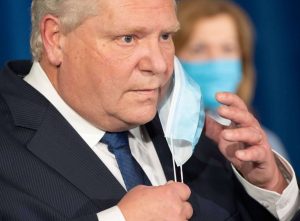Ontario plans for 1st doses of COVID-19 vaccines in all long-term care homes by Feb. 15

Ontario said Wednesday it plans to administer the COVID-19 vaccine in all nursing homes and high-risk retirement homes by Feb. 15.
In a technical briefing this morning, members of Ontario’s vaccine distribution task force said that residents, workers and essential caregivers at those facilities will get their first doses by that date.
The plan builds on an earlier pledge to give the COVID-19 vaccine to long-term care facilities in hot spots by Jan. 21.
Officials said the government is now able to move the Pfizer-BioNTech vaccine safely to long-term care facilities, which has allowed it to speed up immunizations in nursing homes.
Long-term care homes have been hit hard during the pandemic, with 3,063 residents dying with COVID-19 since March.
The province said it had administered more than 144,000 doses of the COVID-19 vaccine as of Wednesday. Futher, about 8,000 people have now received the two doses of the vaccine required for full immunization.
The province is currently focusing on vaccinating health-care workers and those in long-term care facilities but says people over the age of 80 will be the first priority group to receive the shot when Ontario enters the second phase of its vaccine rollout in April.
Confusion around stay at home order
Meanwhile, the provincial government is expected to provide more details today regarding its newly issued stay-at-home order, as public health units reported another 2,961 cases of COVID-19 and 74 more deaths of people with the illness.
The province said it will publish the “legal parameters” for the order, which takes effect tomorrow, online today and offer more clarification on the measure.
As of Thursday, residents will have to stay home except for essential purposes such as grocery shopping, accessing health care and exercising. Here’s what you need to know about the new rules.
The province said police and bylaw officers will have the power to enforce the stay-at-home order and issue tickets to rule-breakers, but hasn’t given details on how that will play out in practice.
In a statement Wednesday morning, the Canadian Civil Liberties Association (CCLA) said it is concerned about enforcement of the order, and the lack of detail so far “around the accommodation of constitutional freedoms.”
Michael Bryant, executive director of the CCLA, said that Ontario cannot ticket its way out of a pandemic.
“During the first wave of the pandemic, there were a disproportionate number of tickets for the homeless, the vulnerable and for racialized minorities,” Bryant said.
Ontario under 2nd state of emergency
The order was announced yesterday as the province declared a state of emergency — its second of the COVID-19 pandemic — and unveiled a series of new restrictions meant to slow the spread of the virus.
They included prolonging the pause on in-person learning in schools in five southern Ontario hot spots — Toronto, Hamilton, Peel, York and Windsor-Essex — to at least Feb. 10.
Child-care centres for kids not yet in school will remain open, however.
The government also restricted hours of operation for non-essential retailers currently offering delivery and curbside pickup to between 7 a.m. and 8 p.m., and imposed a five-person cap on outdoor social gatherings.
Wearing a mask is also now recommended outdoors when physical distancing is difficult.
No paid sick days in revised plan
Notably absent from the province’s plan were paid sick days for low-wage and essential workers.
During a briefing Tuesday, two doctors helping to guide Ontario’s COVID-19 response said that more social supports, particularly paid sick days, would be essential to limiting further cases of the illness.
The lack of paid sick days for many of the province’s essential workers continues to be a major barrier to reducing transmission of the novel coronavirus in many of the hardest-hit communities, said Dr. Barbara Yaffe, Ontario’s associate chief medical officer of health.
“People need to be supported to do the right thing,” she told reporters.
Furthermore, the medical officers of health in both Toronto and Peel Region have repeatedly called for the provincial government to offer relief for workers who can’t afford to take time off if they fall ill.
Speaking yesterday, Premier Doug Ford said he does not want to double-up on a federal program that offers $500 per week for those who need to take time off work to isolate. Critics, though, have pointed out that the federal initiative does not offer job protection and works out to less than minimum wage.
The new restrictions were announced hours after the province released projections that show the virus is on track to overwhelm Ontario’s health-care system.
The forecasts indicate deaths from COVID-19 will surpass those in the pandemic’s first wave unless people dramatically reduce their contact with others.
Death toll now at 5,127
The new cases reported today include 738 in Toronto, 536 in Peel Region, 245 in Windsor-Essex, 219 in York Region, 171 in Hamilton and 154 in Ottawa.
Other public health units that double- or triple-digit increases were:
- Waterloo Region: 146
- Niagara Region: 131
- Durham Region: 119
- Middlesex-London: 103
- Halton Region: 88
- Lambton: 72
- Southwestern: 52
- Simcoe Muskoka: 50
- Brant County: 22
- Sudbury: 18
- Haldimand-Norfolk: 16
- Chatham-Kent: 14
- Eastern Ontario: 12
- Wellington-Dufferin-Guelph: 11
- Huron-Perth: 11
- Peterborough: 10
(Note: All of the figures used in this story are found on the Ministry of Health’s COVID-19 dashboard or in its Daily Epidemiologic Summary. The number of cases for any region may differ from what is reported by the local public health unit, because local units report figures at different times.)
The seven-day average of new daily cases fell for a second straight day, down to 3,480 from a pandemic high of 3,555 on Monday.
Ontario’s network of labs processed 50,931 test samples for the novel coronavirus and reported a test positivity rate of 6 per cent, down slightly from recent days, which have seen rates above 7.5 per cent.
There were 1,674 patients in hospitals with COVID-19. Of those, 385 were being treated in intensive care and 276 required a ventilator to breathe.








Redes Sociais - Comentários